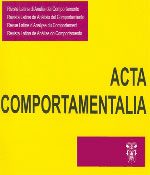Les applications éduçationnelles et cliniques de la théorie de l'équilibre molaire
Main Article Content
Abstract
Some of the most controversial issues in behavioral economics, ethology, behavioral ecology and behavior analysis are optimization, behavior regulation and self-control of organisms in artificial or natural environments. These concepts may be somewhat different but they all refer to the same questions: are organisms able to always choose the most probable source of reinforcement, and if so, how do they reach their goals without having to lay too much effort? Or, how do they respond to environmental constraints and how are some of their behaviors strengthened by reinforcement process and how other are suppressed? Do organisms have a tendency to maintain an equilibrium state between the time allocates to several activities when new environmental constraints are imposed? For thirty years, several models have tried to account for empirical data obtained from operant or microeconomic research: the economic theory of molar maximization (Rachlin, 1982), the molecular maximization (Shimp, 1969), the matching law (Herrnstein, 1970), the molar equilibrium theory (Timberlake and Allison, 1974), etc. This paper presents the molar equilibrium theory, -often called the response deprivation or the conservation theory- and its theoretical implications. But first, the Premack principle is reviewed since it is a precursor of the equilibrium theory and since some authors have compared their predictions within the same experimental design. This paper focuses on research with human subjects and reviews the eight applied studies based on this hypothesis. The advantage of a behavioral strategy based on response deprivation hypotheses instead of the Premack principle is obvious: it is possible to increase an instrumental response with any behavior already in the repertoire of the organism. A renforcement effect will be obtained when the relative availability of a contingent response is under its baseline level. Six out of eight studies, realized in educational or clinical settings, show positive outcomes. The results show that academic behaviors of regular students or mentally deficient children, social skills and verbalizations of psychotic patients, fruit juice drinking by preschoolers, or pain complaints by a worker are sensitive to response deprivation. But despite these outcomes, and the experimental evidences of the validity of the model, it is obvious that this molar theory had not a strong impact on applied behavior analysts who seemed to prefer much more molecular perspectives in their behavioral studies. The conclusion focuses on the lack of unification between experimental analysis of behavior and applied behavior analysis.
Article Details
Citas en Dimensions Service

<a rel="license" href="http://creativecommons.org/licenses/by-nc-sa/4.0/"><img alt="Licencia de Creative Commons" style="border-width:0" src="https://i.creativecommons.org/l/by-nc-sa/4.0/88x31.png" /></a><br />Este obra está bajo una <a rel="license" href="http://creativecommons.org/licenses/by-nc-sa/4.0/">licencia de Creative Commons Reconocimiento-NoComercial-CompartirIgual 4.0 Internacional</a>.
